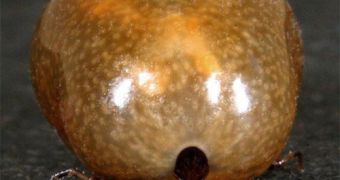You hear about AIDS everyday, while the Lyme disease may sound unknown to you. Still, after AIDS, it is the disease with the most rapid development, spreading rapidly in US, Asia, Europe and South America.
The disease was discovered three decades ago near the city of Lyme (Connecticut). There was a mysterious outbreak of arthritis cases. Most of the victims were children. The arthritis started with eruptions, head and joint aches, but caused sometimes severe physical inability. The cause was found to be Borrelia burgdorferi, a spirochete bacterium living inside the ticks.
The infected ticks can be taken during a walk through the forest, and when they bite, they inoculate into the human bloodstream the bacteria. In nature, the ticks flourish on deer, but as we encroach increasingly into the natural habitats, we expose ourselves more to the ticks.
The first symptom of Lyme is a skin eruption named migrant erythema (ME), which first looks like a little red spot. Days or weeks later, the ME extends turning into a circular, triangular or oval eruption, from the size of a coin till spreading over your whole back. The eruption is often accompanied by fever, head aches, neck stiffness, articular and muscular pains, facial paralysis, meningitis and exhaustion. Sometimes, there can appear eye inflammations, dizziness, and panting. If untreated on time, in over half of the cases victims' joints swell, inducing excruciating pains, that can last for months.
About 20 % of the untreated patients can get chronic arthritis. Sometimes the disease attacks the nervous system and can provoke heart disease. The long term patients can experience also memory loss, focusing impairments, and changes in the sleep pattern.
Lyme disease is hard to diagnose because its first symptoms look like those of flue or other common infections. Moreover, 25 % of the patients do not display eruptions, disease's only distinctive sign, and most patients cannot tell if they have beaten by a tick, as the tick's bite is not painful.
Also, blood antibody tests cannot make the difference between Lyme and other bacterial infections.
If patients are treated on time, most antibiotics do their job, and healing is complete. Exhaustion and pain can last months after the treatment, but they will gradually disappear, without the need for continuing the treatment. But one infection does not mean that the disease cannot be contracted again.
Best measure for avoiding the disease is in the end avoiding the contact with the ticks. In areas abundant in ticks, walk through the middle of the pathways. Wear long pants, long-sleeved shirts and cap. Put your pants into the socks and wear shoes covering all the foot.
It you wear light colored cloths, it will be easier to detect the ticks. Applying on the skin and clothes bug-repellent chemicals works, but they can have secondary effects on children.
Pregnant women should be extremely aware, as the infection can be transmitted to the fetus, increasing the risk of a spontaneous abort or a still child birth. After a walk, check yourself and your children of ticks, especially the hairy areas of the body. Watch carefully, as immature ticks are as small as the point at the end of this phrase, and can be easily mistaken for a dirt spot. Pets also must be checked, as they too can get this infection.
If the tick is already stuck, do not grab it with the fingers, but with splay-tipped pincers. Catch the tick close to its head, and pull slowly, but firmly, till the tick itself detaches from the skin, without smashing its body. Then cleanse the whole area with an antiseptic. If the tick is removed during the first 24 hours, you can escape without getting the Lyme infection.

 14 DAY TRIAL //
14 DAY TRIAL //